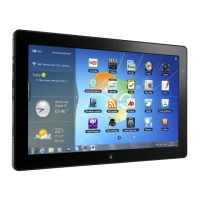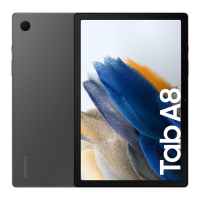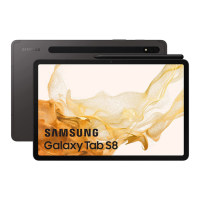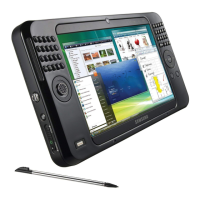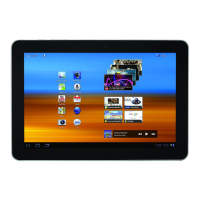Do you have a question about the Samsung XE700T1C and is the answer not in the manual?
Provides essential information and notes before starting to use the computer.
Details warnings and guidelines for safe operation and handling of the computer.
Offers advice on ergonomic practices for comfortable and safe computer usage.
Introduces the computer's design, front, right, left, top, and bottom views.
Explains the procedures for starting up and shutting down the computer correctly.
Explains the role of Windows 8 as an operating system and how to access its help features.
Details the layout and key elements of the Windows 8 Start screen and Desktop interface.
Describes the Charms menu and its functions for quick access to search, share, and settings.
Covers launching, closing, and multitasking with applications in Windows 8.
Provides a reference for keyboard shortcuts to enhance productivity and navigation in Windows 8.
Explains how to use touch operations and the S Pen for interacting with the computer screen.
Describes the functions of the Touch Supporter program for accessing advanced features via touch.
Guides on inserting, removing, and formatting micro SD cards for data storage.
Explains connecting to external displays via VGA or HDMI for presentations or viewing.
Details how to adjust volume using physical buttons or the software volume control program.
Explains how to adjust the LCD screen brightness for optimal viewing and battery saving.
Covers setting up and connecting to a wireless LAN environment.
Explains the NFC function for sharing websites and connecting NFC-enabled devices.
Details how to attach, detach, and use the keyboard dock for laptop-like functionality.
Explains how to initialize, install, and register the TPM for enhanced security.
Covers using S Camera, S Gallery, and S Player for photos, videos, and music.
Explains how to create, edit, and share notes using various formats and features in S Note.
Details how to use AllShare Play for sharing photos, videos, and music across the home network.
Guides on using the SW Update program to keep the system's software and drivers current.
Explains how to use the Support Center to diagnose problems and find solutions.
Covers entering the BIOS setup and navigating its menus for hardware configuration.
Explains how to set up passwords to restrict access to the computer and BIOS settings.
Guides on modifying the boot sequence in BIOS to prioritize USB device startup.
Covers battery charging, usage time, and power management settings for extending battery life.
Details how to restore the computer to factory settings or back up data for future recovery.
Provides instructions for reinstalling Windows using the system recovery media.
Offers solutions to common problems and answers to user queries related to the computer and Windows.
Outlines essential safety instructions for setting up and using the system securely.
Lists compatible replacement parts, accessories, and safety notes for their use.
Details FCC, IC, and EU compliance statements for wireless and telecommunication devices.
Explains the meaning of the WEEE symbol and proper disposal methods for products and batteries.
Provides details on Samsung's program for taking back product packaging for recycling.
Explains the features and benefits of TCO Certified products regarding ergonomics and environmental impact.
Lists hardware specifications, environmental operating conditions, and power ratings.
Provides definitions for key terminology used throughout the user guide.
An alphabetical index of topics and their corresponding page numbers for easy navigation.
Provides essential information and notes before starting to use the computer.
Details warnings and guidelines for safe operation and handling of the computer.
Offers advice on ergonomic practices for comfortable and safe computer usage.
Introduces the computer's design, front, right, left, top, and bottom views.
Explains the procedures for starting up and shutting down the computer correctly.
Explains the role of Windows 8 as an operating system and how to access its help features.
Details the layout and key elements of the Windows 8 Start screen and Desktop interface.
Describes the Charms menu and its functions for quick access to search, share, and settings.
Covers launching, closing, and multitasking with applications in Windows 8.
Provides a reference for keyboard shortcuts to enhance productivity and navigation in Windows 8.
Explains how to use touch operations and the S Pen for interacting with the computer screen.
Describes the functions of the Touch Supporter program for accessing advanced features via touch.
Guides on inserting, removing, and formatting micro SD cards for data storage.
Explains connecting to external displays via VGA or HDMI for presentations or viewing.
Details how to adjust volume using physical buttons or the software volume control program.
Explains how to adjust the LCD screen brightness for optimal viewing and battery saving.
Covers setting up and connecting to a wireless LAN environment.
Explains the NFC function for sharing websites and connecting NFC-enabled devices.
Details how to attach, detach, and use the keyboard dock for laptop-like functionality.
Explains how to initialize, install, and register the TPM for enhanced security.
Covers using S Camera, S Gallery, and S Player for photos, videos, and music.
Explains how to create, edit, and share notes using various formats and features in S Note.
Details how to use AllShare Play for sharing photos, videos, and music across the home network.
Guides on using the SW Update program to keep the system's software and drivers current.
Explains how to use the Support Center to diagnose problems and find solutions.
Covers entering the BIOS setup and navigating its menus for hardware configuration.
Explains how to set up passwords to restrict access to the computer and BIOS settings.
Guides on modifying the boot sequence in BIOS to prioritize USB device startup.
Covers battery charging, usage time, and power management settings for extending battery life.
Details how to restore the computer to factory settings or back up data for future recovery.
Provides instructions for reinstalling Windows using the system recovery media.
Offers solutions to common problems and answers to user queries related to the computer and Windows.
Outlines essential safety instructions for setting up and using the system securely.
Lists compatible replacement parts, accessories, and safety notes for their use.
Details FCC, IC, and EU compliance statements for wireless and telecommunication devices.
Explains the meaning of the WEEE symbol and proper disposal methods for products and batteries.
Provides details on Samsung's program for taking back product packaging for recycling.
Explains the features and benefits of TCO Certified products regarding ergonomics and environmental impact.
Lists hardware specifications, environmental operating conditions, and power ratings.
Provides definitions for key terminology used throughout the user guide.
An alphabetical index of topics and their corresponding page numbers for easy navigation.
| RAM | 4GB |
|---|---|
| Storage | 128GB SSD |
| Display Resolution | 1366 x 768 pixels |
| Operating System | Windows 8 |
| Graphics | Intel HD Graphics 4000 |
| Wireless | 802.11 a/b/g/n |
| Bluetooth | Bluetooth 4.0 |
| Card Reader | microSD |
| Processor | Intel Core i5-3317U |
| Display | 11.6 inches |
| Ports | 1 x USB 3.0, 1 x Micro HDMI |
| Camera | Front: 2 MP, Rear: 5 MP |
